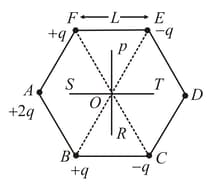B M Sharma Solutions for Chapter: Electric Potential, Exercise 7: Archives
B M Sharma Physics Solutions for Exercise - B M Sharma Solutions for Chapter: Electric Potential, Exercise 7: Archives
Attempt the free practice questions on Chapter 3: Electric Potential, Exercise 7: Archives with hints and solutions to strengthen your understanding. PHYSICS for Joint Entrance Examination JEE (Advanced) Electrostatics and Current Electricity solutions are prepared by Experienced Embibe Experts.
Questions from B M Sharma Solutions for Chapter: Electric Potential, Exercise 7: Archives with Hints & Solutions
charge is uniformly distributed over a long rod of length as shown in the figure. The electric potential at the point lying at a distance from the end is

Assume that an electric field exists in space. Then the potential difference , where is the potential at the origin and the potential at is
A uniformly charged solid sphere of radius has potential (measured with respect to ) on its surface. For this sphere, the equipotential surfaces with potentials and have radius and respectively. Then
Three concentric metal shells and of respective radii and have surface charge densities and respectively. The potential of shell is
Consider a thin spherical shell of radius with its center at the origin, carrying uniform positive surface charge density. The variation of the magnitude of the electric field and the electric potential with the distance from the centre is best represented by which graph?
Two large vertical and parallel metal plates having a separation of are connected to a DC voltage source of potential difference A proton is released at rest midway between the two plates. It is found to move at to the vertical just after release. Then is nearly
A spherical metal shell of radius and a solid metal sphere of radius are kept far apart and each is given charge Now they are connected by a thin metal wire. Then
Six point charges are kept at the vertices of a regular hexagon of side and centre as shown in the figure. Given that which of the following statement(s) is/are correct?

